It seems I haven’t updated this blog in many years. A lot has changed since the last update. I’m now living in Madison, Wisconsin in the USA. I have a lovely girlfriend. And I am brewing beer. So one of the new uses of this blog can be to detail brewing exploits. This is now our fourth batch of beer; I’ll update on the originals at some point soon.
In order, so far we’ve made
Mead (variety of flavours)
Startup Stout (from a kit)
IPA (Extract with speciality grain)
Peculier Christmas (Extract with speciality grain, a clone of “Old Peculier“)
This is our fourth attempt, and this time we’re going Belgian. We both really like Belgian ales, so this is an attempt at a clone recipe of Duvel from Brouwerij Duvel Moortgat. Again it’s a extract with speciality grain brew method. The recipe is from “Best of Brew Your Own” magazine, with a few variations based on the ingredients available at our local supplier.
Ingredients
1.8 lb Extra Light Dried Malt Extract (Muntons)
3.3 lb Light Liquid Malt Extract (Muntons)
3 lb Pilsner Malt
1 lb 11oz Corn Sugar (Kettle) (15mins)
11oz Corn Sugar (Dosage)
1.2oz Styrian Golding / Fuggles hops (We had a little of both so we mixed them) – 60 minutes
1oz Saaz Hops (15mins)
0.75oz Saaz Hops (0mins)
1/4tsp Yeast Nutrient
1 tsp Irish Moss (15mins)
Wyeast Belgian Strong Ale Yeast
Step by Step
A couple of days before we made a half gallon yeast starter by dissolving two cups of dried malt extract in half a gallon of water and boiling it for ten minutes. Then once it had cooled we pitched the yeast and fermented it in one of our 1 gallon demijohns.
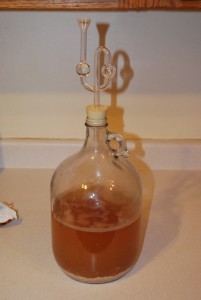
Heat 4.5 quarts water to 160F
Add crushed pilsner malt in a grain bag and turn off heat. Leave to steep for 45 minutes.
While it’s steeping, heat 2.1 gallons of water in brewpot. Once steep is done, add about half the water from the brewpot to the steeping pot. Next, remove grain bag & place in colander over brewpot. Pour the water from steeping through the grain bag into the brewpot.
Bring the brewpot to a boil and add hops, kettle sugar and Irish moss at times shown above. Then turn off heat and add liquid malt extract. Turning off the heat prevents the extract sticking and burning on the bottom of the pot.
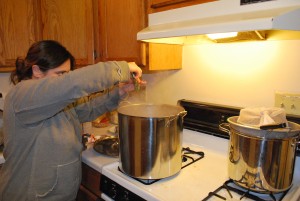
Once the boil is done, add the final hops and cool. We cooled the pot in the sink with some iced water. Contemplated carrying it out into the snow but carrying five gallon pots up stairs with wet feet is no fun..

Cooling took quite a while, had to change the water a couple of times. Maybe outside in the snow would be better.
Finally it cooled. Poured it via a sieve into the carboy and topped it up with water. Lots of hoppy sludge in the bottom tended to block the sieve.
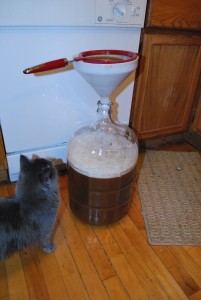
Once topped up with water we pitched the yeast starter slurry and measured the gravity – 1.063. This is a bit lower than the recipe predicts (predicted OG = 1.072). Perhaps we should add some extra corn sugar at the dosage stage to get closer to our target gravity.
We fitted the carboy with a blowoff tube; we’ll ferment at room temperatures around 65F and see what happens.
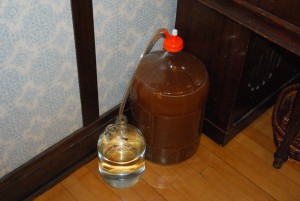
Twelve hours later the fermentation is going strong. Large flakes of protein have coagulated – thanks Irish Moss! – and are swirling round in the carboy.
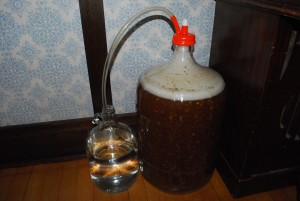

One thought to “Duvel Clone Beer”
is it done yet? is it done yet? is it done yet??? 🙂